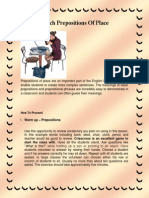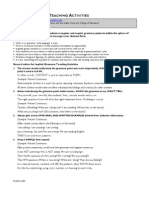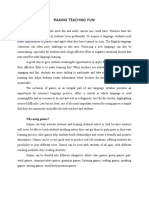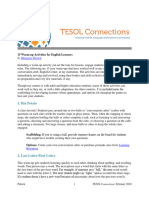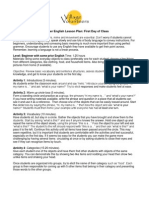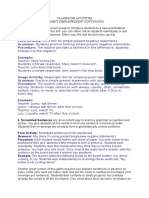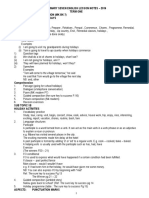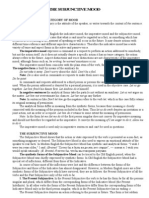TPR Lesson Planning: FL6900 - India - China - USA Workshops Handout Prepared by Shelley Thomas, PH.D
Uploaded by
Anggi Lestari EffendiTPR Lesson Planning: FL6900 - India - China - USA Workshops Handout Prepared by Shelley Thomas, PH.D
Uploaded by
Anggi Lestari EffendiTPR Lesson Planning
FL6900 | India | China | USA Workshops Handout
Prepared by Shelley Thomas, Ph.D.
Introduction
Lesson plan for any one-hour class: Plan for 50 minutes and allow for 10 minutes of classroom
management or unexpected things. Also, have one extra activity in case you finish early. Bonding
activities and ice-breakers should precede TPR lessons (see “preliminary bonding lesson” for ideas for
adults at http://www.acceleratedacquisition.com/workshops.html).
[5 min.] Review of previous day’s target vocabulary
[25-30 min.] New material through actions [5-10 min.]
Processing new material through varied activities [15-20 min.]
[15 min.] Assessing: 5-10 sentences according to time/ pop-up grammar
--Only if students are literate; otherwise, the assessment is simply whether they
correctly respond with their bodies to commands and verbally with “yes/no” or choices.
Try one word assessments: listing verbs on board, numbering them, and having
students match verb with picture. You can encourage student competition to write verb
first and hold up when you say it.
Phase 1: Total Physical Response (TPR)
[For information on TPR read Dr. James J. Asher’s Learning Another Language through Actions]
Preparation: Google clip art and print or use to make a PowerPoint or make stick figure pictures on
sheets and laminate for vocabulary to TPR. Have tape ready to stick them on the board. For examples,
see Ramiro Garcia’s How to Apply TPR for Best Results and The Graphics Book
1. “TPR-able” words: Words that need no translation because they have an immediate
reference—either as a classroom object or the student’s own body. These can be nouns like
“book” or verbs like “stand.” Try to use students’ whole bodies and real objects. You can either
give commands (i.e., use the imperative form) or narrate what “the class does” (i.e., use the
third-person) depending on the way your target language works and which form is used most
frequently.
2. Model / hesitate / stop: Use no more than 3 words at a time and recycle. After that, combine
two commands with “and” and make sure they can do both at the same time: e.g., “touch your
head and sing, jump and turn, raise your hand and walk to the wall.” Use number “one”: e.g.,
“one hand touches the knee, one hand touches the ear, one hand touches the floor, one hand
touches the eye, etc.” This is really funny the faster you go. The hands are flying everywhere.
CALA © 2015 Page 1 of 4
3. Novel commands: Words you have taught but in new, unusual combinations that you do NOT
model. Example: If they know “touch the head” and “touch the table,” give them “the head
touches the table” (but do not model it). The fun for them is getting it alone and, for you,
watching them get it themselves.
4. Vary size of groups: Boys and girls, half the class, three people at a time, etc.
5. Chain commands: Students wait until all 3 commands or narration is given. Three things that
are NOT done at the same time, e.g., “‘walk to the table, pick up the book, put it on your nose.”
You will have to teach them to wait until you’ve finished the third command before they start,
especially if you do not speak their language. Variation: Competition with 2 students. Once 3
commands are given, the first one finished wins.
6. Assess: Have them close their eyes while you give commands. Try to see who may need help
[barometer student]. If less than 80% of the people are getting it, you may need to teach a little
more slowly or fewer items.
Processing Activities
1. Hold two pictures at a time, one in each hand, and call out for one to be pointed to by
students—right hand or left hand. Raise the correct one after.
2. Give verbal choices holding one picture: This is sheltered, authentic communication. “Walk or
sit?” It’s “sheltered” because you are keeping the quantity of target language at a minimum,
and you are modeling the answer to help correct pronunciation. It’s authentic because choice
questions occur all the time in real conversation. Confirm with verbal feedback of the word.
3. Call for five students to stand in front of the class—each holding one picture. As the teacher
calls out the action, the person holding the corresponding picture raises and lowers the correct
picture. Increase speed when you are sure they have it to help them hear target language at
native speed.
4. Stick up the pictures on the board (or pull up a PowerPoint). Number them below and call out
the action in the target language for the students to respond through numbers (in their own
language until they learn numbers in target language).
5. Have students compete to draw quickly on mini-white boards when you shout out action and
tell them to raise quickly when finished. Erasable boards are good, or have them fold 1 paper
into 4 pieces and tear paper for 8 sides to draw on.
6. In pairs, one student draws a picture and shows it to his or her partner and the other says the
command.
7. “Tapette” (fly-swatter activity): Divide the class into 2 teams. The class can select goofy names
and/or a motto. Then call for one person from each group. Have 10 pictures taped to the
board. Give the two people the fly swatters and call out the picture. The first to hit the correct
picture gets the point. It can be played either with two students standing at the board or two
students from far away.
CALA © 2015 Page 2 of 4
8. Charades: Write a simple noun, verb, command, or narrative on slips of paper. Students
choose, read it silently and act it out. Others guess it in the target language.
9. Three-Ring Circus: Put three students up front (have male/female mix), each performing a
different action (but only ONE action). Be careful that it is an action that is not uncomfortable
to repeat, like one person might be touching his head, the other walking to the door and the last
one looking at the window. Then do circle questioning (see the bottom of this list). Use the
students’ names at first then insert “he” and “she” where appropriate.
10. Pop-up grammar: Have written sentences prepared in the target language. The sentences
should be constructed to prompt questions concerning subject/verb agreement, plurals, etc.
First, ask students to report the meaning of the sentence. Then get them to identify the key
grammar structure (e.g., indicator of subject/verb agreement, plural, etc.) in the target
language. Then ask them to find another example among the other sentences. If none, create
another example they haven’t seen so that they can apply it. Introduce them to grammar
according to the meaning and context first. If they are children, there is no need for grammar.
If they are adults in an academic class, make sure they understand the function of the word
when you give the grammatical term, if they want it. The average student does not know
grammatical terms.
o Number the words/sentences and write them on the board or on a worksheet in the
target language. Read sentences in the target language out of order. Students shout
out the number corresponding to the sentence read. Call out in English out of order,
they shout out the number. They translate aloud one by one after you say “who thinks
they can tell me what #1 means?” etc.
11. Variation for teaching “my” and “your”: After the students touch their own body parts, chairs,
tables, words, etc. The teacher teaches “my” and tells the students to “touch MY arms, or MY
stomach, or MY table, etc.” and the kids rush up together to touch the teacher or the teacher’s
things. It is adorable with children and great with adults who have already bonded.
12. Assessment: Write out words that have been TPR’d. First “one at a time” – like just 1 verb or 1
object—not in sentences. If they show mastery of the following routine with one word, then
continue with whole sentences. See if they can tolerate little new additions like plurals,
negatives, and narrative instead of commands.
13. Homework: Have students keep a picture dictionary in the form of index cards to make flash
cards. Each action and noun should have a stick figure drawing they do themselves or they can
find clip art. Encourage using different colors.
CALA © 2015 Page 3 of 4
Circle Questioning
Circling includes posing four (4) questions (from easy to hard). For beginners, use only inflection in the
voice to make the question, keeping the same form used for the statement. New students might
unknowingly repeat the question part of the sentence in their answers because they haven’t had
enough experience to feel it is the part of the sentence that creates the question. After a few
questions, ease into the proper question format. Example:
(1) [+] “He is clapping?”
First students answer “yes” in the target language. The teacher confirms and says, “Yes,
he is clapping” in target language.
(2) [-] “He is jumping?” “
Students answer “no” and teacher confirms, “No, he is not jumping, he is clapping.”
(3) [_/_] “He is jumping or he is clapping?” (choice)
Students answer “clapping” and teacher confirms, “Yes, he is clapping.” When giving a
choice, change only ONE WORD – either the noun, verb, adverb, or subject. For
beginners, use the same words you used in (1) and (2)
(4) [?] “What is he doing?” (open-ended question using key interrogative words)
If there is no answer there is no comprehension, so you should go back to “choice” (3)
and come back to (4)
Example of variation with subject: Do circling with “he” or “she” and your final question
will be “who?”
Example of variation with adverb: Do circling with “quickly “or “slowly” and your final
question will be “how?”
Circling with things like: pictures/people/ clothes/places/food- anything: At first, use only one
thing for all 4 questions and then go ahead with the other things. For more advanced
questioning, mix the 4 levels among many pictures.
CALA © 2015 Page 4 of 4
You might also like
- Whole Brain Cheat Sheet in (Editable Word Format)No ratings yetWhole Brain Cheat Sheet in (Editable Word Format)10 pages
- Understanding Contracts 1: From Normal EnglishNo ratings yetUnderstanding Contracts 1: From Normal English19 pages
- Activity Type: Several Short Speaking Activities Level: A2+ Age: Teenage/Adult100% (1)Activity Type: Several Short Speaking Activities Level: A2+ Age: Teenage/Adult6 pages
- Humanising Decontextualised Grammar: Daniel Martín Del OteroNo ratings yetHumanising Decontextualised Grammar: Daniel Martín Del Otero7 pages
- Why It's So Important For Our Students To Stop Translating and Start Thinking in EnglishNo ratings yetWhy It's So Important For Our Students To Stop Translating and Start Thinking in English9 pages
- Fifty Ways to Teach Them Speaking_ Tips for ESL_EFL TeachersNo ratings yetFifty Ways to Teach Them Speaking_ Tips for ESL_EFL Teachers21 pages
- First Lesson: Low Level Ice-Breaker: 1 December, 2010 Simon ThomasNo ratings yetFirst Lesson: Low Level Ice-Breaker: 1 December, 2010 Simon Thomas1 page
- Warmers & Icebreakers: Universal Activities For Opening LessonsNo ratings yetWarmers & Icebreakers: Universal Activities For Opening Lessons4 pages
- Volunteer Teacher's Toolkit by I-To-I TEFLNo ratings yetVolunteer Teacher's Toolkit by I-To-I TEFL25 pages
- Activities For Tutoring A Pre Literate StudentNo ratings yetActivities For Tutoring A Pre Literate Student4 pages
- Vocabulary Building and Teaching in Lower SecondaryNo ratings yetVocabulary Building and Teaching in Lower Secondary17 pages
- Contoh Lesson Plan Total Physical Response100% (1)Contoh Lesson Plan Total Physical Response12 pages
- Warmers, Ice Breakers S For The Efl ClassroomNo ratings yetWarmers, Ice Breakers S For The Efl Classroom78 pages
- Anggi Lestari Effendi (170210401013) Class ANo ratings yetAnggi Lestari Effendi (170210401013) Class A1 page
- Comparison Song Between Indonesia Pusaka and 17 Agustus 1945No ratings yetComparison Song Between Indonesia Pusaka and 17 Agustus 19451 page
- Why Are These Verbs Troublesome?: Lie / Lay Sit / Set Rise / RaiseNo ratings yetWhy Are These Verbs Troublesome?: Lie / Lay Sit / Set Rise / Raise32 pages
- English Grammar Chart - Adverbs of Frequency100% (2)English Grammar Chart - Adverbs of Frequency1 page
- Unit The Joy of Travel 2 Advanced (B2) Approx. Develop. Time: 5s.x100' Warm Up Presentation Practice Production HomeworkNo ratings yetUnit The Joy of Travel 2 Advanced (B2) Approx. Develop. Time: 5s.x100' Warm Up Presentation Practice Production Homework6 pages
- Bihar Board 10th Political Science Chapter 5 लोकतंत्र की चुनौतियाँ Subjective Question AnswersNo ratings yetBihar Board 10th Political Science Chapter 5 लोकतंत्र की चुनौतियाँ Subjective Question Answers14 pages
- (Ebook) Arabic: An essential Grammar by Faruk Abu-Chacra ISBN 9781315620091, 131562009X - Download the full ebook version right now100% (1)(Ebook) Arabic: An essential Grammar by Faruk Abu-Chacra ISBN 9781315620091, 131562009X - Download the full ebook version right now49 pages
- Four Corners Level 2 Unit 2 Language Summary100% (1)Four Corners Level 2 Unit 2 Language Summary1 page
- Coordinating Conjunction and Compund ClausesNo ratings yetCoordinating Conjunction and Compund Clauses30 pages
- Tenses: Verbs in The Past, Present and Future TenseNo ratings yetTenses: Verbs in The Past, Present and Future Tense28 pages
- Cefr Lesson Plan 2018 (2!10!2018) Speaking Year 3No ratings yetCefr Lesson Plan 2018 (2!10!2018) Speaking Year 31 page
- SSC Stenographer English Practice Set PDFNo ratings yetSSC Stenographer English Practice Set PDF16 pages
- Passive Voice Jeopardy Game Fun Activities Games Games 91550No ratings yetPassive Voice Jeopardy Game Fun Activities Games Games 9155034 pages
- 44 SSC - CGL - English - Day - 44 - 166849672251No ratings yet44 SSC - CGL - English - Day - 44 - 16684967225132 pages
- Fifty Ways to Teach Teenagers: Tips for ESL/EFL TeachersFrom EverandFifty Ways to Teach Teenagers: Tips for ESL/EFL Teachers
- Activity Type: Several Short Speaking Activities Level: A2+ Age: Teenage/AdultActivity Type: Several Short Speaking Activities Level: A2+ Age: Teenage/Adult
- Humanising Decontextualised Grammar: Daniel Martín Del OteroHumanising Decontextualised Grammar: Daniel Martín Del Otero
- Why It's So Important For Our Students To Stop Translating and Start Thinking in EnglishWhy It's So Important For Our Students To Stop Translating and Start Thinking in English
- Fifty Ways to Teach Them Speaking_ Tips for ESL_EFL TeachersFifty Ways to Teach Them Speaking_ Tips for ESL_EFL Teachers
- First Lesson: Low Level Ice-Breaker: 1 December, 2010 Simon ThomasFirst Lesson: Low Level Ice-Breaker: 1 December, 2010 Simon Thomas
- Warmers & Icebreakers: Universal Activities For Opening LessonsWarmers & Icebreakers: Universal Activities For Opening Lessons
- Vocabulary Building and Teaching in Lower SecondaryVocabulary Building and Teaching in Lower Secondary
- The Seven T's of Practical Differentiation: Alphabet Sevens, #2From EverandThe Seven T's of Practical Differentiation: Alphabet Sevens, #2
- Comparison Song Between Indonesia Pusaka and 17 Agustus 1945Comparison Song Between Indonesia Pusaka and 17 Agustus 1945
- Why Are These Verbs Troublesome?: Lie / Lay Sit / Set Rise / RaiseWhy Are These Verbs Troublesome?: Lie / Lay Sit / Set Rise / Raise
- Unit The Joy of Travel 2 Advanced (B2) Approx. Develop. Time: 5s.x100' Warm Up Presentation Practice Production HomeworkUnit The Joy of Travel 2 Advanced (B2) Approx. Develop. Time: 5s.x100' Warm Up Presentation Practice Production Homework
- Bihar Board 10th Political Science Chapter 5 लोकतंत्र की चुनौतियाँ Subjective Question AnswersBihar Board 10th Political Science Chapter 5 लोकतंत्र की चुनौतियाँ Subjective Question Answers
- (Ebook) Arabic: An essential Grammar by Faruk Abu-Chacra ISBN 9781315620091, 131562009X - Download the full ebook version right now(Ebook) Arabic: An essential Grammar by Faruk Abu-Chacra ISBN 9781315620091, 131562009X - Download the full ebook version right now
- Tenses: Verbs in The Past, Present and Future TenseTenses: Verbs in The Past, Present and Future Tense
- Passive Voice Jeopardy Game Fun Activities Games Games 91550Passive Voice Jeopardy Game Fun Activities Games Games 91550









